-
- Market Research
- |
- CBD Near Me
- |
- Giveaways
- |
- Newsletter
- |
- Contact
- |
- Advertise
- |

Finding the right CBD dosage can be difficult with the current lack of clinical research. However, that does not mean CBD users have to be in the dark. Armed with present knowledge and some practical tips, individuals can find doses that are appropriate for them. With inflammation, for example, dosing can depend on the type of inflammation an individual is experiencing (e.g., arthritis). For adults, a possible starting point may be orally taking 20-30 mg of CBD and gradually working up until they experience the effects they want.
Research on CBD Dosages
| STUDY | FINDINGS |
| CBD and Arthritis | Oral CBD doses of 10 mg, 25 mg, and 50 mg were given to mice; 25 mg was most effective |
| CBD in a Simulated Public Speaking Test | CBD doses of 150 mg, 300 mg, and 600 mg were given to men; 300 mg was most effective |
| CBD in Animal Model of Schizophrenia | CBD doses of 15 mg; 30 mg, and 60 mg were given to rats; 30 mg was most effective |
| CBD and Antidepressant Effects in Mice | CBD doses of 3 mg, 10 mg, 30 mg, and 100 mg were given to mice; 30 mg was most effective |
| CBD and Pain in Rats | CBD doses of 0.3 mg, 1 mg, 3 mg, 10 mg, and 30 mg were injected into rats; 3 mg was most effective |
| Cancer Patients and Synthetic CBD | CBD was administered 3 days on and 3 days off; this was found to be more effective than continuous dosing |
Research over the years has found varied information about CBD doses for inflammation and other conditions.
However, several studies have revealed that CBD seems to work in a bell-shaped dose-response curve.
Researchers have found this pattern in several conditions, including anxiety, depression, pain, and inflammation.
Some researchers have found timing (e.g., daily usage or on-off regimens) may also influence the cannabinoid’s efficacy.
The following studies offer some details on what scientific research has found about dosing with CBD.
Study: CBD and Arthritis
Researchers from the Kennedy Institute of Rheumatology in the UK and Hebrew University tested intraperitoneal injection (i.p.) and oral CBD on collagen-induced arthritis in mice, which resembles rheumatoid arthritis in humans.
The mice were treated with CBD for four weeks.
The i.p. doses were 20 mg, 10 mg, 5 mg, and 2.5 mg daily while the oral CBD doses were 10 mg, 25 mg, and 50 mg daily.
Researchers found that the moderate 5 mg i.p. CBD dose and 25 mg oral CBD dose were the most effective at suppressing the inflammation.
These results revealed a bell-shaped curve, and while the researchers did not have an explanation for why CBD did this, they noted, “such behavior has been repeatedly described for cannabinoids.”
Study: CBD in a Simulated Public Speaking Test
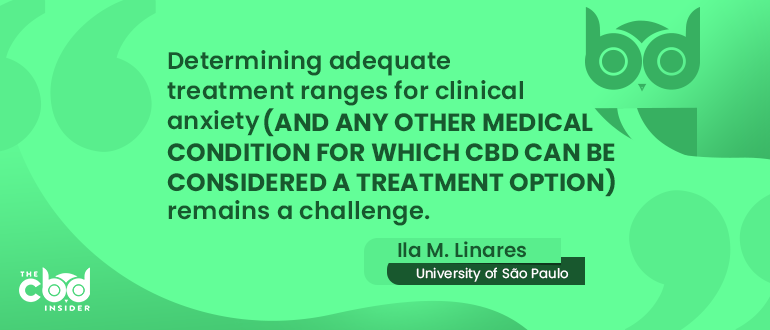
A study by researchers at the University of São Paulo tested the ability of CBD to reduce anxiety in healthy patients with a simulated public speaking test.
The researchers administered three doses (150 mg, 300 mg, and 600 mg) of CBD or placebo to 57 participants.
The doses were administered 90 minutes before the beginning of the speech and measurements of anxiety were conducted five times at various intervals before, during, and after the speech.
By far, the 300 mg dose of CBD was found to be most effective.
Since the window for efficacy with CBD seems narrow, the researchers concluded, “determining adequate treatment ranges for clinical anxiety (and any other medical condition for which CBD can be considered a treatment option) remains a challenge.”
However, they noted that one open-label clinical trial did establish a therapeutic window for epilepsy.
Study: CBD in Animal Model of Schizophrenia
Researchers from the Federal University of São Paulo in Brazil induced rats with schizophrenia and used four treatment options: WIN55212,2 (a cannabinoid receptor activator), rimonabant (CB1 receptor antagonist), AM404 (anandamide uptake inhibitor), and CBD.
One of the characteristics of schizophrenia is a decreased sensorimotor response.
One way to measure this decreased response is to evaluate prepulse inhibition.
Prepulse inhibition (PPI) is when an organism is not as startled by a startling stimulus (the pulse) because the organism heard a less intense version of the startling stimulus immediately before it (prepulse).
For example, if a healthy individual was to hear a sudden, soft burst of white noise immediately before an intense burst of white noise, the individual’s response will be significantly diminished than if the individual had only heard the intense sudden white noise.
In the cases of those with schizophrenia, most patients have a decreased PPI response.
Only WIN and CBD successfully treated the schizophrenic rat model by reversing the decrease in PPI.
Researchers gave the rats three different doses of CBD: 15 mg, 30 mg, and 60 mg.
The 30 mg dose of CBD was the most effective.
The researchers concluded, “The present study suggests a beneficial property of a direct cannabinoid receptor agonist (WIN55,212) and of CBD on the PPI deficits associated to schizophrenia.”
Study: CBD and Antidepressant Effects in Mice
This study by researchers from the University of São Paulo in Brazil tested the antidepressant effects of CBD in mice using the forced swimming test.
In this forced swimming test, mice swam in a cylinder filled with water for 6 minutes. The mice cannot escape, and researchers measure how long the mice are immobile.
Immobility is considered a sign of hopelessness, which researchers typically associate with despair and depression. Historically, antidepressants reduce the time of immobility.
CBD was given to the mice in four doses: 3 mg, 10 mg, 30 mg, and 100 mg.
The 30 mg dose of CBD was the only one that reduced immobility time, but it did so significantly.
“The results of the present study showed that CBD induces antidepressant‐like effects in the forced swimming test,” stated the conclusion of the study.
Study: CBD and Pain in Rats
Researchers at the University of São Paulo in Brazil studied the effects of CBD for pain in rats that had incisions made on their paws.
The researchers measured the pain of the rats by applying force to their paws.
Along with a placebo, the rats were given CBD in five different doses to see which treatment, if any, would allow the rat to endure more force.
Doses were 0.3 mg, 1 mg, 3 mg, 10 mg, and 30 mg. The 3 mg dose allowed the incised paw to endure the most force.
It was a significant improvement from all other doses, especially over the placebo.
The pain relief lasted at least 2.5 hours.
Study: Cancer Patients and Synthetic CBD
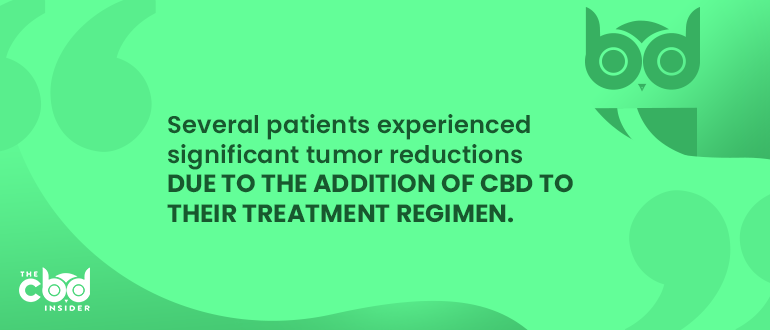
This study by researchers from the Dove Clinic in the UK and St. George’s University of London used synthetic CBD to treat cancer patients.
Most of these 119 patients had metastatic cancer, and 39 of them had breast cancer.
Several of the patients experienced significant tumor reductions due to the addition of CBD to their treatment regimen.
The researchers administered CBD to their patients on a three-days-on, three-days-off basis, “which clinically was found to be more effective than giving it as a continuous dose,” the study states.
This offers a helpful insight into how the timing of using CBD may affect efficacy.
The study concludes that CBD has a “useful role” in cancer symptoms and has evidence of killing cancer cells, but it should not be the sole treatment against cancer.
Tips for Determining CBD Dosages
| TIPS | DESCRIPTION |
| Consider Body Composition | Different body types may determine the concentration of cannabinoid receptors in the body. Generally, higher body weight correlates to the need for higher doses. |
| Know Your CBD Product | Ask yourself several questions: What is the concentration? Is my product an isolate or full-spectrum? What is the administration method, and how will it affect bioavailability? |
| Start Small and Increase Gradually | Since CBD seems to operate in a bell-shaped curve, start with low doses and work up until you reach your desired effect. |
| Be Consistent | No matter what dosing regimen you choose, consistency will provide the best chance for CBD to be effective. |
While research is great, figuring out the appropriate dose for almost any condition is challenging.
This leaves consumers, and researchers, with several questions.
To answer these questions, it is imperative we conduct more clinical studies to confidently determine not only the efficacy but also the safety and necessary dosages of a therapy.
With that said, we can still use the available scientific evidence to help us make wise dosing decisions.
Here are some tips for finding the most appropriate CBD dosage for inflammation and other conditions:
- Consider your body composition
- Consider your condition severity
- Know your CBD product
- Start small and increase gradually
- Be consistent
Consider Your Body Composition
Body mass likely affects the amount of CBD a given individual will need.
While it’s a small sample size, and doses of CBD in preclinical trials for several types of experiments varies wildly, the researchers involved with animal studies used generally low doses (e.g., 1 mg, 3 mg, 10 mg, 30 mg, etc.).
However, in the simulated public speaking test, researchers gave human participants much higher doses (150 mg, 300 mg, 600 mg).
While this does not suggest humans require large doses of CBD for the cannabinoid to be effective, it does suggest that humans need higher amounts of CBD than animals because of their size.
CBD Origin recommends taking 1-6 mg of CBD per 10 pounds of body weight. While this is not based on any authoritative data, it provides a rule of thumb that may be helpful when determining a starting dose.
Consider Your Condition Severity
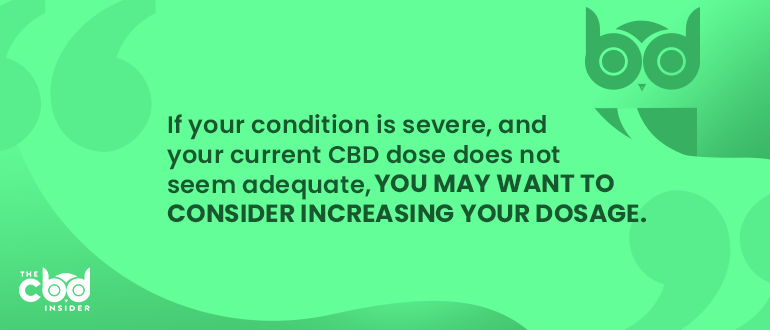
Condition severity can also play a factor in how much CBD you may need to take.
In the study on CBD and cancer, researchers adjusted a patient’s dose depending on the severity of their condition.
“The average dose was 10 mg twice a day. For increased tumour mass, the dose was increased, in some cases up to 30 drops twice a day (30 mg),” the report states.
If your condition is severe, and your current CBD dose does not seem adequate, you may want to consider increasing your dosage.
Know Your CBD Product
CBD products can differ in several categories, such as bioavailability, concentration, and the type of hemp extract.
Bioavailability
Bioavailability is the amount of a substance that enters the bloodstream.
The only method that can provide 100% bioavailability is intravenous administration, which we’ll assume is not something everyone wants to do.
The bioavailability of a particular CBD product is mostly determined by how you consume it (some brands are working on ways to improve bioavailability for certain administration methods).
Determining bioavailability will help you figure out approximately how much CBD is entering your bloodstream, allowing you to more accurately adjust your dosage.
Oral Consumption
For oral CBD products (e.g., capsules, edibles, drinks), bioavailability is likely around 5-15%.
The last study to specifically look at oral bioavailability for CBD was in 1986—which showed a bioavailability of around 6%—so some have looked at studies on THC for guidance.
Studies on THC show anywhere from 4-20% oral bioavailability, which is a large discrepancy, and quite low.
Oral consumption will offer the lowest amount of CBD to your bloodstream than any other method, but it also has some of the longest-lasting effects.
Sublingual Consumption
Sublingual products include oils, lozenges, and sprays that you put under your tongue.
Underneath the tongue is the mucous membrane, which covers connective tissue containing many capillaries.
The capillaries absorb the substance into the bloodstream, bypassing the metabolism of the digestive system, which contributes to the low bioavailability of oral CBD.
Sublingual bioavailability is believed to be around 12-35% according to a study, which is another wide range but indicates sublingual products offer a more reliable absorption rate than taking CBD orally.
It also seems to have long-lasting effects.
Inhalation
Inhaling CBD may be the best way to take the cannabinoid regarding bioavailability.
One study found a rate of 34-46% bioavailability.
Inhalation is also one of the quickest ways to get a substance into the bloodstream and notice the effects.
Vaping and smoking are popular methods of inhaling CBD, but nebulizers with CBD treatment have also shown promising results for providing therapeutic benefit.
While inhalation is one of the best ways to take CBD, the effects do not last as long.
Rectal
The rectal route, administered with suppositories, seems to be another reliable way to absorb CBD.
Some sources have claimed that it offers more than twice the bioavailability of oral consumption.
Others say it may be much lower and rates could vary wildly.
According to anecdotal evidence, effects seem to be quick and last longer than other consumption methods.
Concentration
Determining concentration is simple.
The packaging should state how many milligrams of CBD/cannabinoids are in the product and how much CBD/cannabinoids are in each serving.
To get a more precise measure of the cannabinoid content of a product, consult the certificate of analysis for the batch the product originated from.
Full Spectrum vs. Isolate
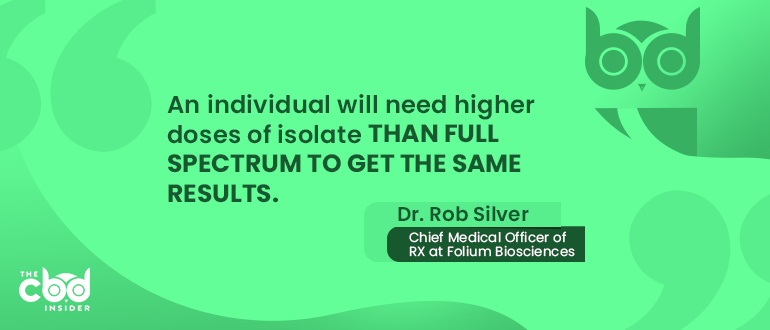
Another aspect to consider is if your product is isolate or a full-spectrum extract.
According to Dr. Rob Silver, the Chief Medical Officer of RX at Folium Biosciences, an individual will need higher doses of isolate than of full-spectrum to get the same results.
Unless an individual is subject to drug testing, full-spectrum products seem to be the best choice for efficacy due to the entourage effect and principle of whole plant medicine.
However, a need does exist for THC-free products.
If you need THC-free products, that does not necessarily mean you must take isolate.
An alternative to CBD isolate is broad-spectrum CBD.
Broad-spectrum items include most of the cannabinoids and terpenes found in full-spectrum extracts but contain no THC.
This may be more effective than CBD isolate alone.
Start Small and Increase Gradually
While you can do all the homework possible to determine how much CBD may be best, you never know how your body will react.
It is always better to start on the conservative side and readjust afterward.
Increase your dose gradually until you reach your desired effect.
Be Consistent
This may be the most important tip.
No matter how you take CBD, whether it’s every day or with an on-off regimen, consistency is key.
Long-term dosing with CBD may also offer other benefits to overall health.
According to Project CBD, “Prolonged low dose therapy may be advantageous for managing chronic symptoms or to prevent disease recurrence.”
Since preclinical evidence indicates CBD may possess preventative benefits, such as neuroprotection, taking CBD consistently over time may make you less susceptible to specific ailments.
Did you find these tips helpful? Let us know how you take CBD in the comments below!
Disclaimer: The content on this site is for informational purposes only. We are not medical experts and nothing should be construed as medical advice. Be sure to speak with your physician before taking CBD or any other treatment.


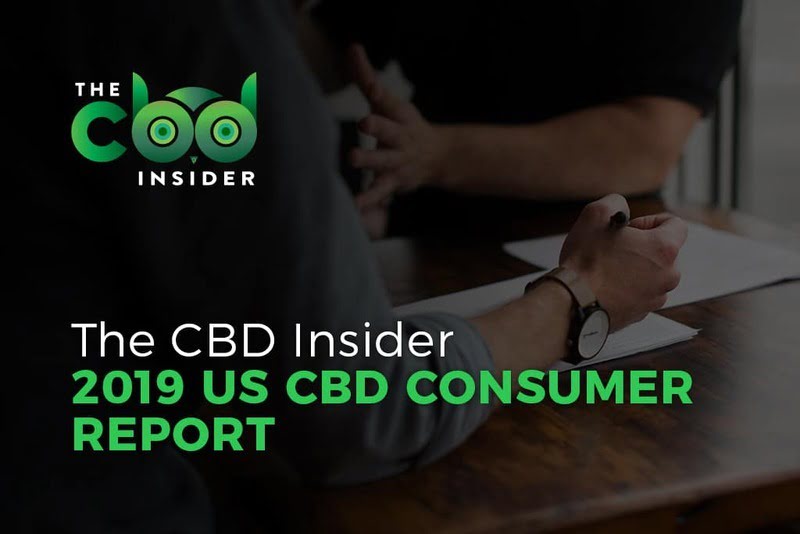
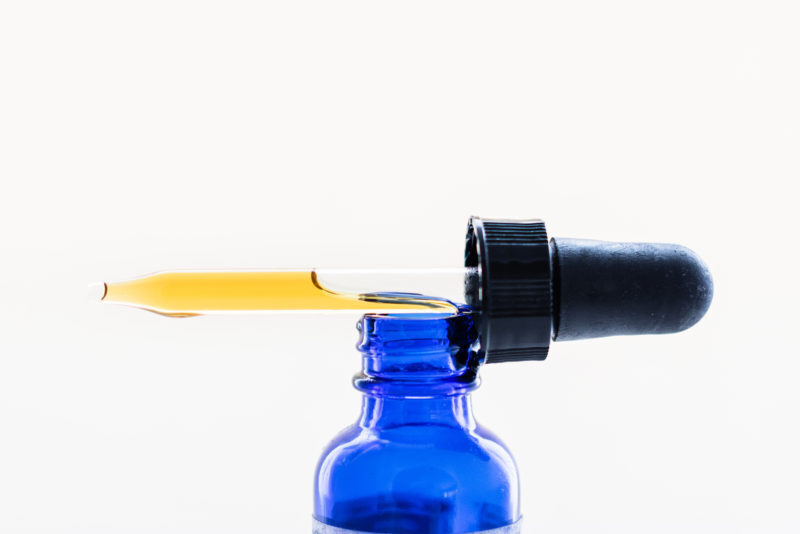
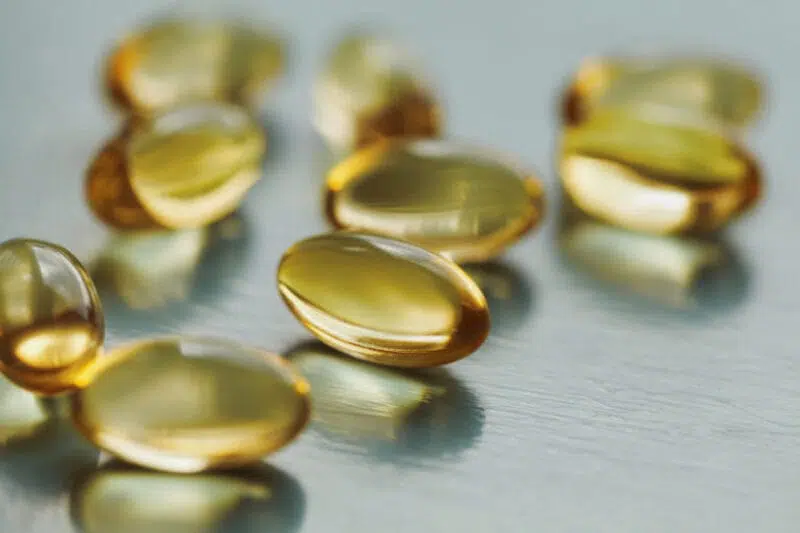
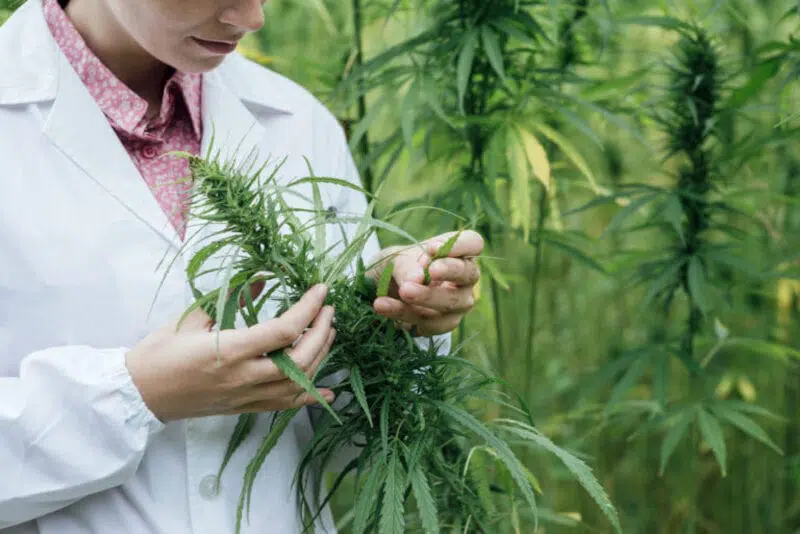
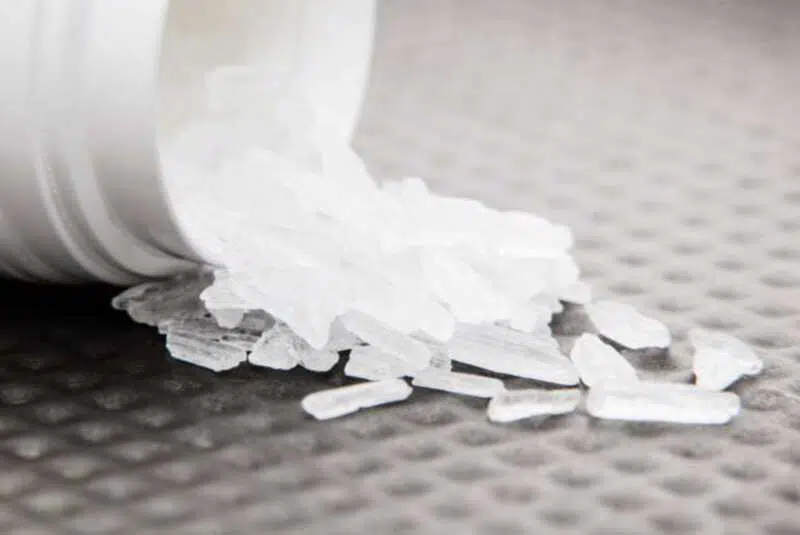
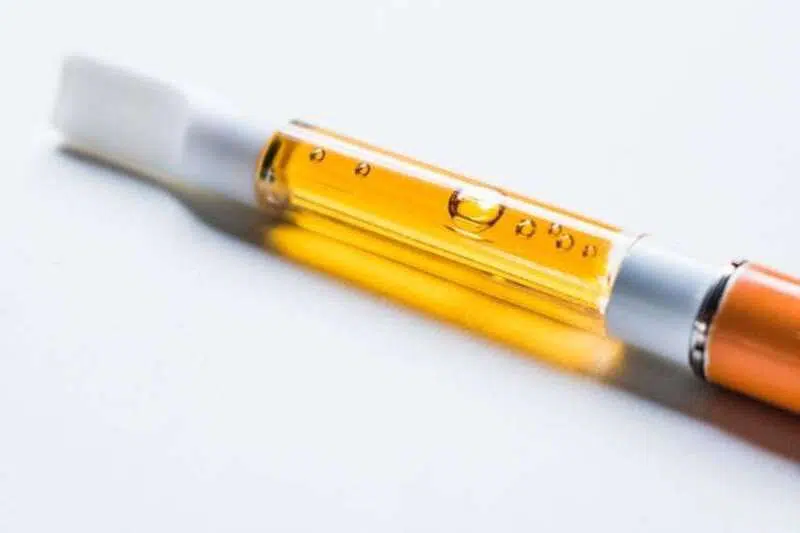
1 Comment
Inflammation causes a lot of problem, from acne, obesity to cancer all can be caused by inflammation.
CBD can literally change the life of anyone suffering from inflammation